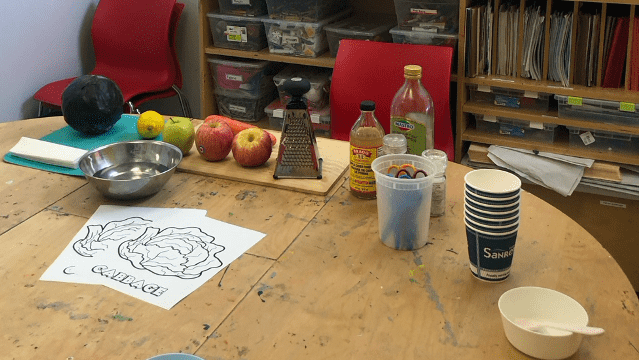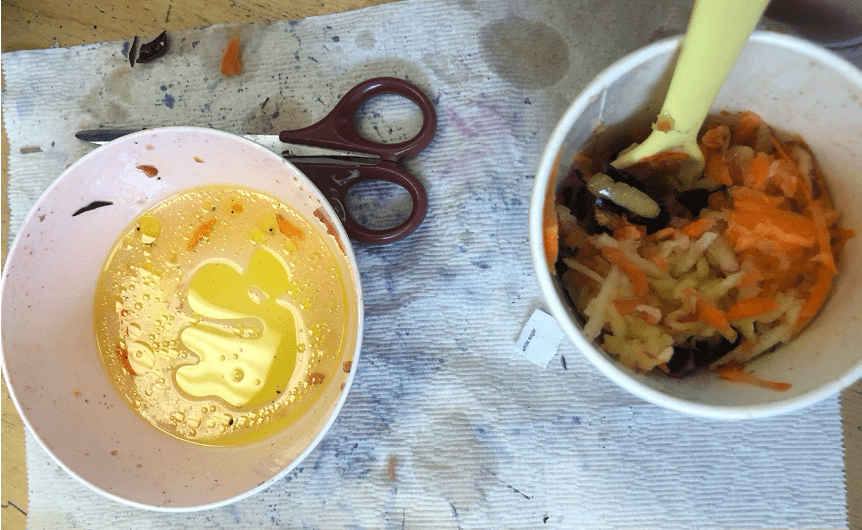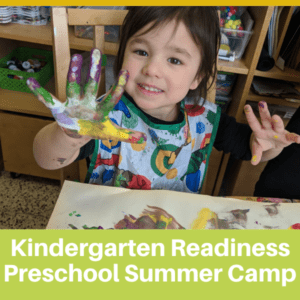
The versatility of cabbage when cooking with kids cannot be emphasized enough. Whether you’re lighting roasting or sautéing the leaves to introduce some oil and salt tastes, searing cabbage-steaks to absorb some Dijon and maple flavours, or munching on it raw in this egg-free coleslaw recipe, kids have ample opportunities to focus on the many ways it can be prepared and their reaction to the variations, rather than deciding the foods merit based on one flavour profile. Fundamentally, it encourages kids to think of foods and flavours for their many potentials, rather that determine if it belongs in the favourite or least favourite food categories.
Read below for a description of the recent egg-free coleslaw we made in our Urban Farming & Cooking Class. We explore the recipe itself, scissor and grater safety, and utilizing alternative food prep methods kids are familiar with…snowflakes!
Sharp Tools with Kids
Using sharp tools is always a daunting task at first, however implementing some safety tips, reinforcing communication, and maintaining a slow and patient pace both during instruction and the task itself is key to introducing the skills safely.
Using a Grater
- Select a grater with a small surface area to minimize contact with skin. We opted for this small triangular grater so there would be less exposure to their enclosed hand than a rectangular box grater option.
- Have the child hold the item that they are grating with the hand they write with. They can place their non-dominant hand on the grater alongside yours to steady it.
- Leave the end of the grated item on (ie. End of a carrot) so there is more room to hold.
- Grate from the top to the bottom. Ask them why grating bottom to top or back and forth might be less safe (demonstrate with your own hand grating).
- Grating back and forth or bottom to top exposes more of their skin and makes the grater less steady as they move up.
- Line up their knuckles and make a connecting circle with their thumb and pointer finger to prevent any fingers sticking out towards the grater. We recommend holding your hand in front of theirs between them and the grater until you feel confident that they can perform the motion without adjusting their hand.
- If they can this, stand by their side and ensure they maintain a slow pace. If they can’t then keep your hand between theirs and the grater but have their movement drive the item down the grater so they still feel in charge of the task.
Using Alternative Methods – Cabbage Snowflakes
Introducing, snowflake cooking! Similar to cutting a snowflake from paper with child scissors, this method can be used on a variety of vegetables.
- Start with sanitizing the scissors – this is a great opportunity to explain why we clean all of our cooking tools before we cook.
- Review the safe use and transport of scissors:
- When moving with or passing scissors, encourage them to hold the scissors pointed down, with their fist around the closed blades.
- We only direct scissors in the direction we are cutting, on the material we are cutting.
- Close the scissors blades and rest it in the centre of the table when we are done using it (not at the edge, not left with blades open).
- Classic coleslaw has long thin stripes, however encourage the kids to get as creative as they’d like as they cut up their cabbage leaf into a snowflake, and then cut up the snowflake itself. They can always return to their mixing bowl and cut any larger pieces smaller, however they’ll enjoy the autonomy to decide the size and shape of their recipe’s main ingredient.

The Recipe – Egg-free Coleslaw
The first step in any recipe:
- Wash your hands! Cooking together is a great way to reinforce good hygiene habits. As well, so we don’t get any olive oil on our face or in our hair, we also find it helpful to tie all long hair into a bun or pony tail before we start cooking.
Ingredients:
- Cabbage – purple cabbage is great to add colour to the recipe, and explore how water and paper towel collects the colour as well.
- Carrot
- Apple
- Lemon
- Olive Oil
- Apple Cider Vinegar
- Salt
- Pepper
- Optional:
- Teaspoon of sugar, honey, maple syrup
- Mustard (honey or Dijon)
Steps:
- Shred the cabbage, utilizing the snowflake method described above
- Shred the carrot(s) and apple(s) with the grater (raise the grater to check how much you’ve collected and ask your child if they would like to have more or less, empowering them by giving them control over the recipe’s proportions)
- Whisk together the dressing:
- a capful of olive oil (have them tip this into the mixing bowl)
- a ¼ slice of lemon (have them squeeze this in)
- Salt and pepper (small jars with twist grinders are a great way to designate this task to your child to complete at their discretion)
- A capful of apple cider vinegar (have them tip this into the mixing bowl)
- Optional – add a tablespoon of Dijon or honey mustard
- Optional – add a teaspoon of sugar, honey or maple syrup
- Whisk together!*
- Add the dressing over the shredded apple, carrot, and cabbage. Let sit for 30 minutes to soften the cabbage (but enjoy fresh as well if preferred, and then compare the texture change).
*Bonus Activity – Oil and Vinegar Experiment: Emulsions
Before mixing, whisking or shaking up the dressing, encourage your child to observe how olive oil and the apple cider vinegar separate. Explain that oil and vinegar have something called molecules within that only want to stay with their friends and stay separate.
You can additionally explore the time it takes for oil and vinegar to split again after being shaken together, and then how it compares to adding mayonnaise and mustard (because they posses emulsifiers). Make predictions on what will separate again and when, and what mixtures will stay together.
Other additions:
- Add mayonnaise to make a creamy dressing.
- Add raisins to add more sweetness.
- Add some greens – from chopped spinach to fresh parsley, make a tester tasting bowl and encourage your child to explore how the greens change the taste and decide if they would like to add to their recipe.
We learned a lot of cool facts in class about how this brassica grows, but we always love seeing the growing process in action. Here’s the video of a cabbage from seed to harvest: https://www.youtube.com/watch?v=XTWQNz1YGyM

Questions & Prompts:
- How would they describe the flavour – we try to engage in the five core flavour profiles: salty, sweet, sour, umami and bitter
- Where are these tastes on their tongue? Do they change as time goes on?
- What vegetable tastes similar? Or are these completely new tastes?
- What’s the difference between the taste of the carrot, apple, and cabbage? What makes them similar?
- What is the texture like? Is it crispy, mushy, crunchy, hard, soft, moist, dry?
- How did the texture or flavour change after the dressing sat on the carrots, apples and carrots?
Fun Facts and Health Benefits:
Fun Facts & Health Benefits – Carrots
- A light frost can convert some of the vegetable’s starches to sugar, sweetening a carrots taste
- Their ancestor is Queen Annes Lace, which has a white root and woodier taste than the carrots we eat today
- One serving of carrots delivers over 100% of the recommended daily value of vitamin C, and are also high in vitamin C, and some B vitamins
Carrots are something called biennial plants, meaning they need two growing seasons to produce seeds and will only flower after they’ve been left in the ground into their second year
Fun Facts & Health Benefits – Cabbage
- They belong to the same vegetable family as: brussel sprouts, broccoli, cauliflower, kale and kohlrabi
- The waxy coating on cabbage leaves keep the plant warm in its preferred cool climates. Exploring this texture and making observations on how it feels, and then predictions on why it feels how it does is a great way to get the creative juices flowing before you start cooking!
- Cabbage is a great source of vitamin C, K and B6 in addition to other nutrients
- Cabbages are 90% water
Get updates on new classes, hosted events, and more.










